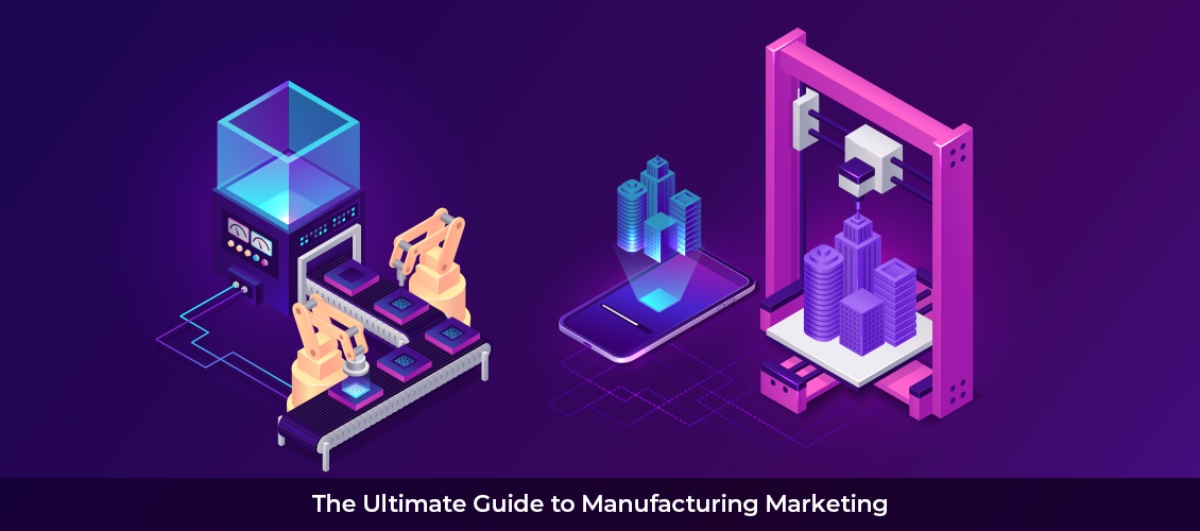
When you market in any industry, the number one priority is the customer.
However, many manufacturing companies struggle to translate this concept into their marketing strategies. More than half of all manufacturing marketers (55 percent) state that their top challenge is overcoming the traditional marketing-and-sales mindset. They’re stuck advertising like they did a decade ago – and that’s not going to give them the results they need in these times.
To meet the needs and expectations of modern customers, manufacturers must embrace the chance to improve their marketing strategies. Learning to market and reach out to customers properly will lead to more qualified leads, increased revenue, and a wealth of business opportunities.
In this guide, we’ve rounded up some of the key elements of strong marketing, as shared by the experts of our online marketing agency.
We’ll tackle everything, from breaking down the manufacturing sales funnel to discussing various methods of content creation, lead generation, website development, and much more.

1. Understanding the Sales Funnel for Manufacturing Marketing
First things first: manufacturers need to understand the different stages of the buyer’s journey, specifically within their own industry.
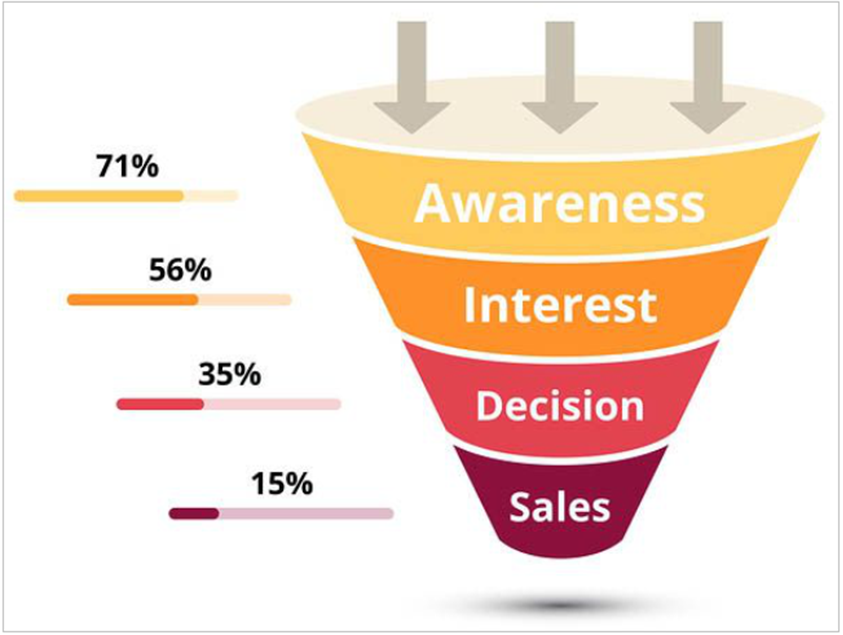
Image Source: Sales Funnels Expert
Step
01
Consumers Become Aware of Your Brand
The first step in the buyer’s journey is simple: learning that your manufacturing brand exists.
This is when a customer stumbles into your store, or more likely, comes across your manufacturing website or content. They learn your name and develop an initial understanding of what your brand offers and the value you can provide to them.
Step
02
Your Company Piques Interest
During step number two, your potential buyers take a deeper look at your manufacturing company. They either form an interest in your services/products – or they don’t.
This is your opportunity to showcase exactly how you provide solutions to manufacturing-related problems or needs. Answer questions and make your brand’s selling points clear.
Step
03
Buyers Realize the Value of Your Products
Your brand had a chance to strut itself in step two. Now, it’s time for buyers to determine what your products/services are truly worth to them – monetarily and beyond. This is the key part of the buyer’s process.
Can you truly impress upon your buyer why they need to work with your manufacturing company?
Step
04
Seal the Deal
Last but not least, you convert your interested shopper into a committed buyer. This is done by answering all their questions, clearing up any doubt, and solidifying the fact that you are the best possible solution to their problem.
The sale is completed, and now, you’ve got a customer in the bag.
You might be wondering, “Okay, but what does all of this have to do with marketing?”
Well, as we delve deeper into this topic, you’ll soon realize that almost every part of essential manufacturer marketing fits into this buyer’s journey. Your marketing strategies are the map, and your team members are the cartographers.
Now, it’s time to lead your buyer’s straight into your desired sales pool.
2. Goals for Marketing for Manufacturers
Speaking of your desires, what are your goals for your manufacturing company? Why are you reading this post and trying to improve your marketing tactics?
Let’s take a look at some of the most common ambitions shared by manufacturers. All of these goals have a lot to do with strong marketing – and we’re going to explain why.
Leads
Did you know that roughly 71 percent of manufacturing content marketers list lead generation as their top organisational goal?
For any company, more qualified leads = more opportunities to turn a profit. Your team is hoping to reel in more interested parties with great marketing – and therefore have a chance to convert more prospects into paying customers.
Any custom marketing strategy worth its stuff works to help you generate more leads via content creation, digital advertising, customer engagement, and a whole spectrum of other tactics.


Revenue
This next manufacturing goal seems pretty obvious: bring in more money – period.
Whether you’re finding new customers or simply encouraging old ones to return, marketing should help your company achieve new revenue heights. Smart advertising allows you to appeal to buyers on just the right level, pique their interest, and convince them to spend money with your manufacturing company.
Branding
Another goal shared by many manufacturers is the aim to breathe life into your brand.
Although most of us will agree that manufacturing companies aren’t the easiest to personalize, it’s essential that you humanize your brand enough to engage customers on a deeper level.
A big part of great marketing is cultivating an excellent brand design – one that makes your manufacturing brand appear more credible, trustworthy, and appealing than your competitors’ companies.
Excellent marketing helps with creative branding through custom website design, personality development, smart messaging, and general identity cultivation.


Scaling
If you want your brand to grow (and you should), you’ll need to have a plan for adapting to that growth.
As your manufacturing company increases in size and success, you’ll face new challenges – like adjusting to a larger audience, garnering more publicity, and recruiting more employees. Expert marketing will help you break through these obstacles and scale your growth effectively.
Setting Your KPIs
The last marketing manufacturing goal we want to point out is the chance to set your KPIs (key performance indicators).
How do you know what factors indicate your brand’s success or failure?
What elements reveal your manufacturing marketing ROI?
By analyzing the right data for sales, advertising, content production, team management, and more, you will put yourself in a better position to effectively implement custom marketing strategies that drive your brand’s future.

3. Challenges of Manufacturing Marketing
Hopefully, you’ve now thought a little bit about what your goals as a manufacturing company are – and how custom marketing can get you the results you seek.
Moving on, let’s talk about some of the obstacles you’re probably facing in your marketing, as well as how you can combat them with the right strategies.
A. Targeting the Right Audience
Addressing just the right audience is a struggle for many industries, but we find it’s especially challenging for manufacturers, who often face large audiences on an international scale.
Unique Challenges Manufacturing Content Marketers Face

Image Source: Industrial Marketing Today
Not only does your marketing need to potentially appeal to people from around the globe, but it also needs to reach multi-level roles while conveying semi-complex messages.
As you can imagine, it’s not necessarily a simple task.
The solution for this challenge comes down to the discovery process. The goal is to understand who you are as a brand, the value you provide to the industry, the problems you solve, and who you aim to help.
To learn more about finding your target audience, talk to one of our experts at Curve Communications. We’ve developed a time-tested discovery process to pinpoint your most ideal customers – and how we can set up a thorough manufacturing marketing strategy to find more of them.
B. Determining What Kind of Content to Publish
Your next issue is figuring out the best kind of content to create and share. Content is the backbone of your inbound marketing strategy. If you’re not producing the right kind, you’re missing out on a wealth of opportunity.
What does your content production team need to focus on? Blogs? Landing pages? Case studies? White papers?
How Manufacturing Marketers Rate Their Organization’s Overall Level of Content Marketing Success
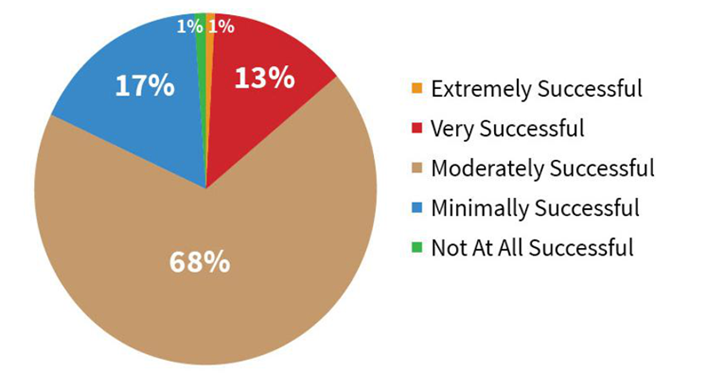
Image Source: Content Marketing Institute
As the graphic above indicates, about 68 percent of manufacturing marketers feel their content marketing is “moderately successful.” Another 17 percent think theirs is only “minimally successful.”
Why do so many manufacturers feel poorly about their content marketing?
Our guess is that most are posting the wrong kinds of content.
Think back to the buyer’s journey we discussed at the beginning of this guide. The goal of your content is to funnel your perfect customers from steps one to five. That means creating content that improves their awareness, grabs their interest, and provides real value.
If you’re not sure where to start with content creation, we suggest taking an informative standpoint. Instead of thinking of your content or blog as a sales tool, think of it as an educational opportunity to win over skeptical readers.
We often push our manufacturing clients to produce informative blog posts, e-books, news releases, and guides. Focus on providing your readers with real value – and the sales will follow.
C. Managing Your Website
Manufacturers, both big and small, face the challenge of consistently updating their websites to appeal to consumer taste.
Your website is your hub, your digital representation, and your chance to put your best foot forward. In the outbound and inbound marketing realm, your website is your most valuable asset.
At the end of the day, all of your marketing strategies point customers back to your website. Content, social media campaigns, emails, pop-up ads – they all encourage customers to visit your website.
Your website can’t be some run-of-the-mill platform. It needs to be fine-tuned for easy navigation, customer appeal, and conversions. Investing in expert website design and development is perhaps the best thing you can do to nurture interested visitors into paying customers.

For starters, every website today should have:
- A clean look that’s simple and straightforward but simultaneously modern and advanced.
- Responsive mobile design - since many viewers are on cell phones or tablets.
- HTTPS encryption to defend against cybercrime and make visitors feel safe.
In most cases, your website is your first chance to impress a buyer. This is their initial interaction with your company – and it needs to be a good one.
D. Properly Setting Up CRM and Marketing Automation Systems
Your team may be facing the challenge of automating your marketing efforts.
The simpler and faster you can make your marketing plan, the more time your team has to focus on bigger projects and business growth. Now’s the time to look into CRM and marketing automation systems, but picking the right one is easier said than done.
At Curve Communications, some of our favorite systems include:
If you need guidance on picking (and implementing) the best automation system, talk to our marketing team. We’re equipped to match you with a system that meets your expectations and budget – and start pulling in qualified leads.
4. How to Do Marketing for Manufacturing Businesses
Now that we’ve discussed common goals and obstacles for manufacturers, let’s get to the real meat of this guide: creating a marketing plan that works.
These are the top steps you need to tackle if your strategy is to take flight. Trust us: skipping even one of these tasks can lead to sub-par results and lots of wasted time and effort.
A. Create a Buyer Persona
The first to-do we want to discuss is defining your ideal customer(s). This is an enormously important part of targeting the right audience and crafting effective marketing messages. The more detailed your personas are, the easier it is to get your marketing plan right on the first go.

Image Source: Sevaa Group
As you develop your customised marketing strategy, get really specific about your buyers. Before diving deep into the discovery process, ask yourself the following questions:
- Who are my manufacturing company’s ideal buyers?
- What do these buyers look like?
- How do they act?
- What are my customers trying to achieve?
- Which obstacles do my ideal customers face?
The more detail you can provide for a buyer persona, the easier it will be to target them with precision.
When it comes to manufacturing marketing, you likely have more than one type of persona you’re attempting to engage with, and that’s alright. Take a hard look at your best customers and come up with some categories.
For example, are you mostly selling to design engineers? MRO managers? Procurement teams?
Don’t assume you already know what your ideal buyer personas look like. Take the time to conduct real research – this will fuel smart, impactful marketing strategies in the near future.
B. Design the Perfect Website
We’ve already touched on the importance of having a mobile-responsive, neat, impressive website, but let us say it again: your website needs to be flawless.
Some even argue that your website plays the most important role in your inbound marketing strategy, above any content or ad tactics.
As you look into custom website design and development services to improve (or build) your manufacturing website, you need to focus on the following elements in order to create a site that markets for itself.

a. Easy-to-Manage CMS
Your CMS (content management system) dictates how simple it is to create, manage, and change content on your website. This includes your graphics, code, and overall design.
You need a CMS that’s easy to use so you can consistently adapt your digital marketing strategies within your website’s setup. Look into popular choices like WordPress or Magnolia for systems that make adaption simple.
A website shouldn’t be a stagnant entity but an evolving representation of your brand. A good content management system helps manufacturers achieve this.

b. SEO
If you want your manufacturing website to rise up the ranks of popular search engine results, you’ll need a solid SEO strategy in place.
Ensure your website is optimized with the right manufacturing keywords, expert content, and a setup that Google favors. Failing to keep SEO in mind as you design your website will make it significantly more challenging to find new leads organically.

c. Copywriting
As your website design takes shape, the importance of the text on every page cannot be overstated. Not only is copywriting a part of SEO, but it’s also extremely important when it comes to customer perception.
Think about it this way: would you trust a manufacturing company whose website is littered with poorly written, incorrect copy? Or would you go for the brand with attention-grabbing, grammatically correct text?
Don’t just slap some words on the homepage and call it good. Recruit strong copywriters who will help your website pack just the right amount of punch.

d. Easy Navigation
A whopping 94 percent of respondents in a Small Biz Trends survey indicated that easy navigation is the most useful feature on any website. This is especially true on manufacturing websites – people want to find what they need immediately without sifting through lots of complicated information.
Give your website an easy-to-follow setup, a helpful search bar, and any other features that will make it functional for a variety of users.

e. Third-Party Lead-Tracing Tools
While giving your manufacturing website a facelift, you need to implement some lead tracking tools. Apps like Zoho, Salesforce, and Quick Base will help you better organise all of the relationships you make with incoming customers.
Immediately plug signed-up users into your email system, create customized dashboards for tracking, forecast sales, and personalize the user experience.

f. Active Blog
We discussed how important it is to educate your visitors with expert information as a part of your manufacturing marketing strategy. An on-site blog provides the ideal platform for doing just that.
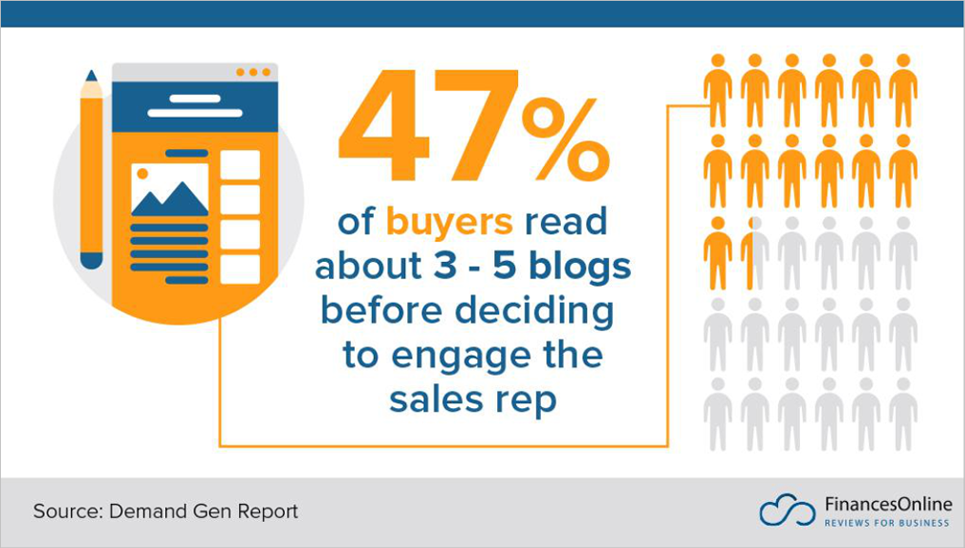
Image Source: Finances Online
A large chunk of your website visitors will check out your blog before they make any moves toward purchasing. Give them posts that are
full of quality writing, eye-catching headlines, and information that really benefits them.
g. Beautiful Design
This might sound like a no-brainer, but remember: your website needs to be be
aesthetically pleasing.
Just because the site is for a manufacturing company doesn’t mean that it should be bare-bones and boring to look at. First impressions of a brand are 94 percent design-related, so make sure that your website gives your brand the best chance at impressing viewers.

C. Planning Different Types of Content
Only about 40 percent of manufacturing marketers always/frequently craft content based on their average customer’s journey.
Ignoring your manufacturing marketing sales funnel is a surefire way to create ineffective content. Your website should be a pedestal for content that plays right into the buying journey – and that means creating different types of content for different purposes.
Let’s break it down. Here are the three basic stages of the buyer’s journey – and the types of content that best fit within each step of the process.

The “Awareness” Stage
In this stage, people are looking for answers. This is where you want to provide educational, top-level content, like e-books, blog posts, social content, and general information. You might even produce a few videos to catch their eye in this initial step.

The “Interest” Stage
If someone has made it to this stage, you’ve caught their attention. This is your chance to draw them in deeper – perhaps with some testimonials and case studies that reveal just how beneficial your products/services could be for their problem.

The “Decision” Stage
Don’t skip on any stage of the buyer’s journey as you create content. Each part of the process is essential and requires specific marketing messages
D. Picking Channels for Content Distribution
You’ve created content for each stage of the buyer’s journey, but you’re not done yet. You need to determine how you’re going to share this content for the best audience engagement and response.
What channels are you creating content for?
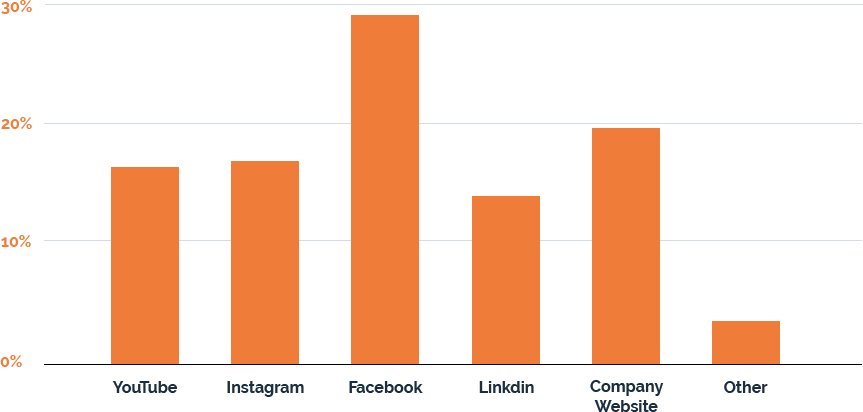
Image Source: HubSpot
As you can see from the graph above, social media is typically the distribution channel of choice – specifically Instagram, Facebook, and LinkedIn. YouTube is also highly valued these days.
Unfortunately, there’s no right or wrong answer that we can direct you toward when it comes to picking distribution channels. It all depends on where your target audience hangs out and what kind of content you’re sharing.
What we can tell you is that we’ve seen many of our manufacturing clients succeed with strong distribution on their own website. Creating videos, blog posts, podcasts, and other content for their website has led many manufacturers to directly reach customers on the hunt for answers.
Still, it’s not a bad idea to plan out a few other distribution channels in your manufacturing marketing plan. Consider the best social media platforms for your particular business and progress from there.
E. Measuring ROI
Last but not least, we’ve got one more big marketing topic to tackle: measuring your return on investment.
If you really want to know how successful (and worthwhile) your marketing services are, you need to understand exactly how much revenue you’re receiving compared to how much you’re investing.
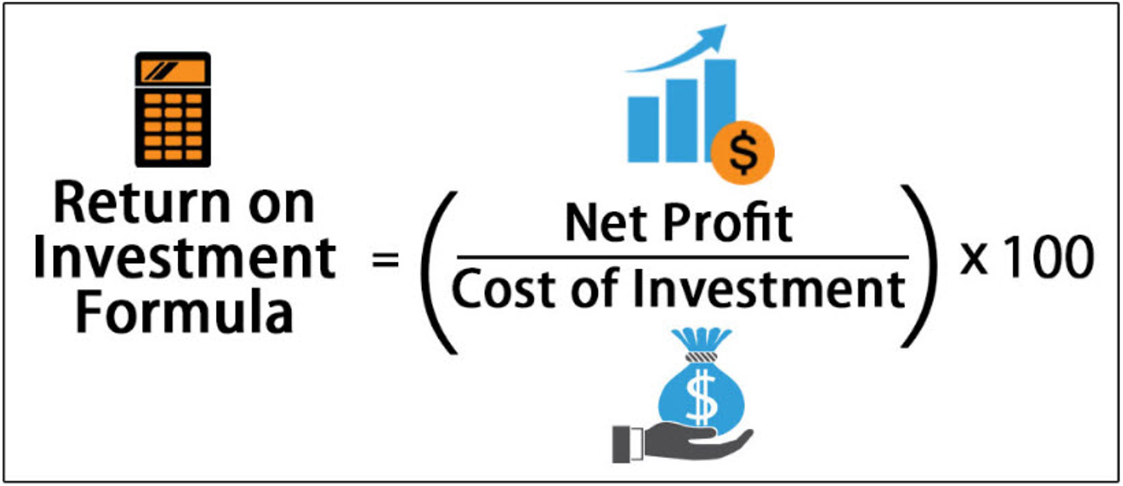
For all types of digital advertising, traditional advertising, outbound marketing, and inbound marketing, you want to feel good about your investment. It’s all about balancing the risk with the reward to achieve the perfect setup for your manufacturing brand.
To keep track of your marketing campaigns and their success, you need to be keeping a close eye on your marketing data and CR. You’ll need to have a data-backed understanding of what’s working, what’s not working, and where your greatest challenges and opportunities lie. The goal is to justify every single dollar in your budget.
Measuring ROI is not always apples-to-apples. Do yourself a favor and leave it to the experts!
Conclusion
Hopefully, our ultimate guide to manufacturing marketing has given you some strong launch pads for igniting your own strategies.
If you’re still feeling a little lost, or possibly overwhelmed by all of the information we just threw at you in 3,000+ words, reach out to the team at Curve Communications.
Our traditional & digital marketing agency has extensive experience partnering with manufacturing businesses just like yours. Let us take your marketing plan – and your company – to the next level. You’re ready to go, and we’re ready to make your dreams a reality.




